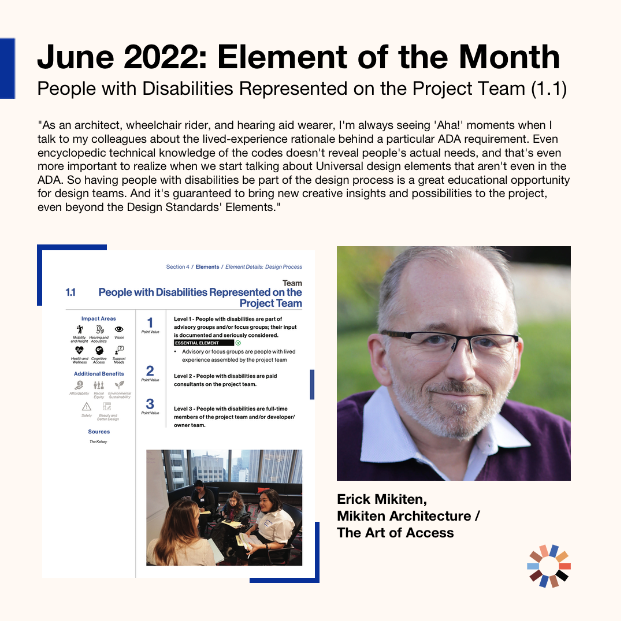The Housing Design Standards for Accessibility and Inclusion equip designers, builders, and developers with guidelines and frameworks for disability-forward housing creation. It highlights cross-disability accessibility and design decisions that are anchored in inclusion. Each month we feature one of our partners and the Element they’re most excited about.
Erick Mikiten / Mikiten Architecture & The Art of Access
The Housing Design Standards for Accessibility and Inclusion were co-created by people with and without disabilities. It’s essential that people with lived experience are able to influence and drive how homes and communities are created. For the creation of the Design Standards, we worked with an Inclusive Design Council, a team of disabled designers and advocates from across the country who helped define elements and the standards overall. This lived experience leadership is an element that Erick Mikiten, of Mikiten Architecture and the Art of Access, values. Erick was a key consultant to develop the Housing Design Standards for Accessibility and Inclusion and has been an architect in many disability-forward housing communities. As a person with multiple disabilities and a designer, Erik believes “that to have an inclusive project, you need an inclusive process.” He values the lived experience and the expertise that a diverse team can offer. His spotlight element is People with Disabilities Represented on the Project Team.
Element: People with Disabilities Represented on the Project Team (1.1)
- Level 1 – People with disabilities are part of advisory groups / focus groups shaping the project with documented ability to shape and define the project.
- Advisory or focus groups are people with lived experience assembled by the project team
- Level 2 – People with disabilities are paid consultants on the project team.
- Level 3 – People with disabilities are full-time members of the project team and/or developer/ owner team
Design Category: Design Process
Impact Area(s): All
Why is this element important to you, personally or for the project?
As an architect, wheelchair rider, and hearing aid wearer, I’m always seeing “Aha!” moments when I talk to my colleagues about the lived-experience rationale behind a particular ADA requirement. Even encyclopedic technical knowledge of the codes doesn’t reveal people’s actual needs, and that’s even more important to realize when we start talking about universal design elements that aren’t even in the ADA. So having people with disabilities be part of the design process is a great educational opportunity for design teams. And it’s guaranteed to bring new creative insights and possibilities to the project, even beyond the Design Standard’s Elements.
What recommendations would you make to someone designing a disability-forward housing project (related to the design standards)?
In order to create an inclusive project, you need an inclusive process. The Design Standards were born out of inquiry and an inclusive process themselves, but it doesn’t end there. Each geographic area and each community has unique needs, and each project team can continue to engage with people with disabilities to create even more equity and inclusion!
